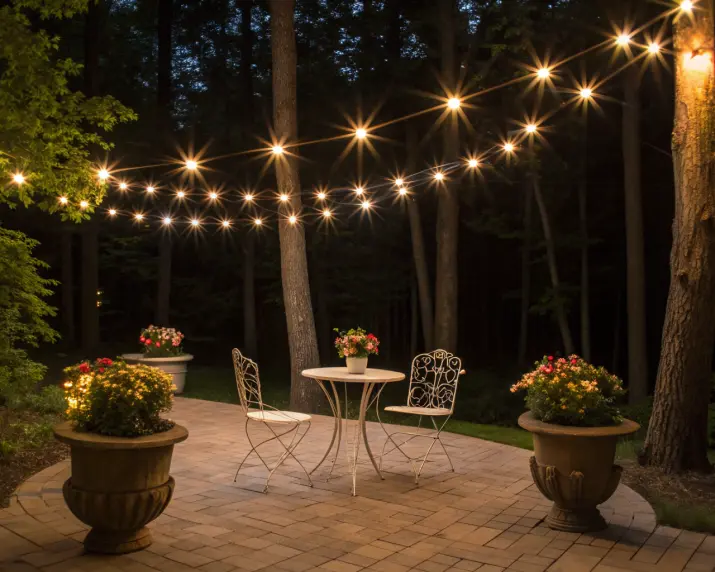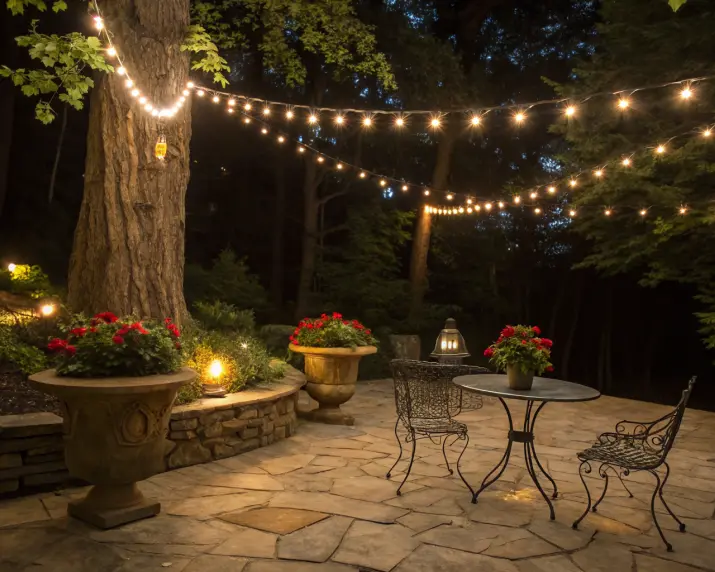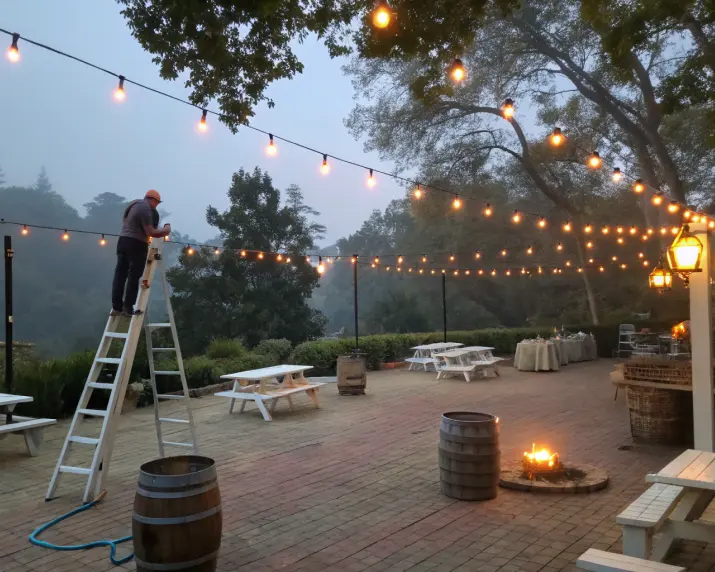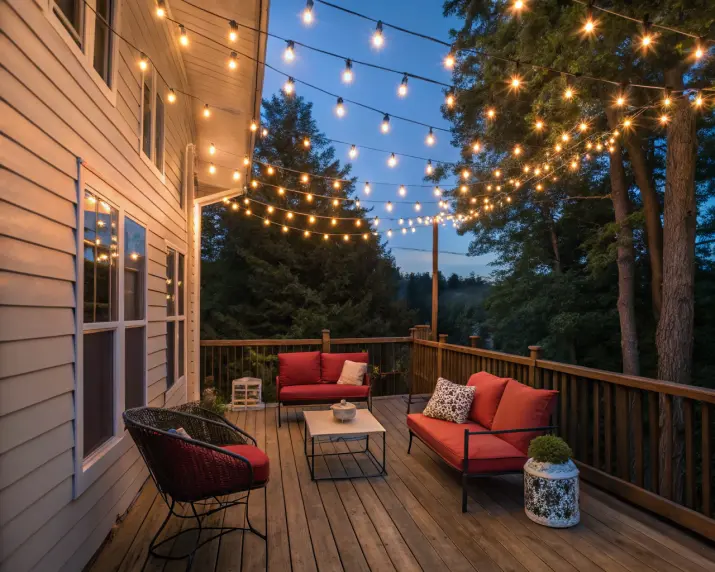Patio lighting is one of the easiest ways to completely change how your outdoor space feels. The key is finding the right mix of function, atmosphere, and careful planning. Good lighting not only improves visibility but also adds warmth and character to every corner.
This guide walks you through everything you need to know about how to install patio lights, from mapping your layout and choosing hardware to handling electrical connections and creating the look you want. Whether you prefer a simple plug-in setup or a more advanced wired design, you’ll learn how to bring your outdoor lighting ideas to life.
Planning Your Patio Lights Installation

Before buying anything or drilling a single hole, take time to plan properly. Measure your space, figure out power requirements, and decide what style you’re after. This planning prevents expensive mistakes and ensures you buy the right materials the first time.
Measure Your Space
Grab a measuring tape and note the dimensions of your patio or deck including the length, width, and height to mounting points. Draw a rough sketch showing where you might hang lights. This doesn’t need to be perfect, just functional enough to reference while shopping.
Add 2 to 6 feet to your measurements when calculating light strand length. String lights create natural curves between mounting points. That swing or drape you see in pictures happens because the lights aren’t pulled tight. If you measure 20 feet between two points and buy exactly 20 feet of lights, you’ll have a straight, tight line with no character.
For larger spaces or complex patterns, graph paper helps visualize the layout. Mark your patio dimensions, note the nearest outlet location, and sketch where lights will hang. This method makes it obvious how many strands you need and where the hardware gets mounted.
Locate Your Power Source
Find the nearest outdoor outlet to your planned installation area. GFCI-protected outlets are required for outdoor lighting. These outlets have distinctive test and reset buttons. If your existing outdoor outlet isn’t GFCI protected, replace it before connecting lights. This protection prevents serious shock hazards in case moisture gets in.
Choose Your Light Style
String lights come in several popular styles, each creating different effects:
Globe Lights: Round bulbs ranging from golf ball to softball size. These classic bistro-style lights work for nearly any setting and provide good illumination for functional lighting.
Edison Bulbs: Vintage-style lights with exposed filaments. They create a warm, nostalgic atmosphere perfect for intimate gatherings. The larger bulb format makes a bigger visual statement.
Fairy Lights: Tiny bulbs on thin wire, often battery-powered. These work well wrapped around posts or trees, but don’t provide much functional light. Better for accent than primary illumination.
Cafe Lights: Larger commercial-grade bulbs spaced farther apart. These deliver serious lumens for outdoor dining areas and cover more space per strand.
Select Your Pattern
How you hang lights matters as much as what lights you hang. Popular patterns create different vibes:
Perimeter Lighting: Strands follow the edges of your patio or deck. Simple to install and defines the space boundaries. Works well for covered patios where you’re attaching lights to existing roof structures.
Zigzag or W Pattern: Lights crisscross the space in angled lines. This pattern provides good coverage and visual interest. Requires at least five mounting points for proper execution.
V Pattern: All strands meet at a central point and fan outward. Creates a dramatic canopy effect. Remember that the central mounting point bears double the lateral tension from lights pulling in two directions.
Grid or Square: Straight lines running parallel across length and width. Looks structured and modern. Provides excellent, even illumination.
X Pattern: Lights form an X across the space. The curved triangle version with 45-degree angles looks better than straight 90-degree crosses because it contrasts with the square edges of most patios.
Draped or Scalloped: Lights hung around the perimeter with pronounced swags between mounting points. The dramatic curves offset the simple square layout.
Choose patterns based on your mounting options and space shape. A narrow deck might work best with simple parallel lines, while a large open patio can handle complex crisscross patterns.
Safety Requirements for Installing Patio Lights
When learning how to install patio lights, safety should always come first. Water and electricity can be a dangerous combination, so it’s important to follow proper precautions and use outdoor-rated materials. Make sure all connections are weatherproof, outlets are GFCI-protected, and wires are securely fastened away from moisture and foot traffic. By taking these steps, you can complete your installation safely and enjoy your new lighting setup with confidence.
GFCI Protection is Required
All outdoor outlets powering your patio lights installation must have GFCI protection. This isn’t optional or recommended; the electrical code requires it. GFCI outlets detect ground faults and cut power within milliseconds, preventing electrocution.
Test GFCI outlets monthly by pressing the test button. The reset button should pop out, indicating the protection circuit works. If nothing happens, replace the outlet immediately.
Some standard outlets receive GFCI protection from upstream GFCI outlets or breakers. A GFCI tester from any hardware store verifies protection on standard outlets. Don’t assume protection exists without testing.
Use Weatherproof Connections
All electricity access from outside must be weatherproof. This applies to outlets, junction boxes and all other wire connections. Water resistant boxes and covers prevent moisture from seeping in. Electrical connections are adversely affected by water because it causes shorts, fires and shock hazards.
For outlets, you’ll want weatherproof “in-use” covers that keep the connection covered even when your cords are plugged in; regular weatherproof covers protect only an empty outlet while still exposing a live connection to the elements.
Never Work on Live Circuits
Shut off the power from the breaker when working with any electrical equipment. Check to ensure power is off using a voltage tester, not simply flipping off the switch. Breakers can fail. Circuits can be mislabeled. Always test before touching wires.
If you don’t feel comfortable working in electrical panels, hire a licensed electrician. The service wires from the power company remain energized even with the main breaker off. One mistake in a panel box can mean severe injury or death.
Proper Cable Burial Depth
Direct burial cable, such as UF (underground feeder), should be buried at least 12 inches deep for 120-volt circuits. Planting shorter increases the risk of damage from shovels, garden tools and on foot traffic. Provide conduit protection where the cable leaves the ground to enter fixtures or outlets.
If you are trenching, mark where the cables will be laid before burial. Any future landscaping or digging projects will want to know where buried lines run. You may consider using bright warning tape 6 inches over the top of underground cable as an additional safety precaution.
Extension Cord Safety
Outdoor extension cords must be rated for exterior use. Check for “W-A” or “W” designation in the cord type marking, indicating weather-resistant and waterproof construction. Indoor extension cords used outside break down quickly and create fire risks.
Don’t daisy-chain multiple extension cords. This creates a voltage drop that stresses lights and generates heat at connection points. If your power cord won’t reach, use a single longer extension rated for the total wattage you’re drawing.
Load Calculations Matter
Refer to the manufacturer for the maximum number of connected strands. Most commercial-strength string lights can be connected end-to-end with two or more sets before another outlet is needed.
Note: To prevent overloading, do not exceed the maximum lamp load at any one time when in operation. Measure total wattage before plug-in. For 15-amp circuits, the maximum total connected load should be limited to less than 1,440 watts. For 20-amp circuits, the number is 1,920 watts. The result, far from ‘bricking’ a PS2 console, can at best trip the breakers and at worst bring forth fire.
Installing Patio Lights: Step-by-Step Methods
Different mounting situations require different approaches. Your specific installation depends on what structures exist and where you want lights to hang.
Mounting to Existing Structures
For covered patios with roof overhangs or pergolas with beams, mounting hardware to existing structures is straightforward.
Cup Hooks or Eye Hooks: Screw them into wood beams, soffits or posts. For the best bonding results, hand screw installation is recommended on wood material with a pre-drilled hole at least as deep as the length of the plastic you have.
Screw Eyes: Similar to cup hooks but with a closed loop. Better for applications where you’re using a guide wire or want a more secure attachment. Stainless steel versions resist corrosion better than galvanized options in coastal areas.
Space mounting points based on how much sag you want in your lights. Closer spacing creates flatter, more taut lines. Greater spacing allows for dramatic swoops and curves. Most installations look best with 8 to 15 feet between mounting points.
Install hooks 8 to 10 feet above the ground at a minimum. This provides clearance for people walking underneath without stooping. Taller mounting creates more elegant proportions but may be harder to reach for maintenance.
Using Guide Wire for Support
For longer runs or heavy commercial-grade bulbs, the guide wire removes strain from light strands. This technique dramatically reduces sagging over time and protects light wiring from stress.
Install the guide wire (also called a guy wire) between the anchor points first. Use a vinyl-coated steel cable rated for outdoor use. Secure each end to sturdy eye hooks or eye bolts. Pull the guide wire taut using a turnbuckle for adjustment.
Once the guide wire is installed and tensioned, attach light strands to the wire using small pieces of wire, zip ties, or specialized light clips. The guide wire bears the weight and tension while the lights simply hang from it.
This method works particularly well for V patterns where the central mounting point would otherwise face excessive force from multiple light strands pulling in different directions.
Creating Freestanding Light Poles
When you lack existing structures for mounting, build standalone light poles. Several methods work depending on the permanence needs and budget.
In-Ground Posts: The most permanent option. Dig holes 2 to 3 feet deep, insert 4×4 treated lumber or metal conduit posts, and fill with concrete. Allow concrete to cure fully before hanging lights. Attach eye hooks or brackets at the desired height.
Planter Poles: Mix quick-dry concrete in large planters, insert posts while wet, and hold centered until the concrete sets. Fill the remaining space with soil and plants. This approach creates portable poles that won’t damage your patio surface. Works for smaller patio areas but lacks stability for large installations.
Umbrella Base Poles: Use patio umbrella stands as bases for conduit poles. Drill holes through the pole at your desired light height and insert eye bolts. Completely portable and requires no permanent installation. Ideal for renters or temporary setups.
Space freestanding poles around your patio perimeter at intervals matching your desired light pattern. For square perimeter lighting, one pole at each corner works. For more complex patterns, additional poles in strategic locations provide mounting points.
Attaching to Trees
Mature trees provide natural mounting points but require careful technique to avoid harming the tree.
Never nail or screw directly into trees. This damages bark and creates entry points for disease and pests. Use alternative methods that don’t penetrate bark.
Strap Methods: Wide, soft straps that wrap around the trunk distribute weight and won’t cut into bark as the tree grows. Look for straps specifically designed for tree mounting applications.
Hook Over Branches: For informal installations, you can simply drape lights over sturdy branches. This works but limits control over exact placement and height.
Trees must be mature and healthy enough to support the weight and tension. Small or young trees bend under the load, creating uneven light lines and potentially damaging the tree.
Mounting to Deck Railings
Decks with railings offer built-in mounting infrastructure. Several specialized products make railing mounting simple.
Deck String Light Poles: Pre-made poles with bases that clamp to deck railings. Install these at corners or along railings where you want lights to terminate. Height-adjustable options let you fine-tune the look.
Railing Hooks: Small hooks that mount to the top rail of your deck. These work for lighter-weight lights and casual installations. More affordable than dedicated light poles, but they provide less height and drama.
For railings, you can also mount eye bolts directly through posts if you’re comfortable drilling. This creates the most secure attachment but requires permanent modification to your deck.
Hardwiring vs Plug-In Options
Plug-in lights are used most often in residential patio light installs. They are easy to install, easy to replace when they fail, and do not require permits or inspections.
The problem with hardwiring string lights to your electric system is that it’s complicated. The majority of string lights are not intended or rated for permanent hardwire connections. Trimming the plug to hardwire them is against the electrical code and voids warranties.
For lights you want to control from an indoor switch, your best bet is usually a switched outdoor receptacle. Wire the receptacle into your switch circuit, and any lights that you plug into this switched outlet will operate in sync. This unlocks switch control without the lights coming unscrewed from their intended plug and cord.
And for permanent installations that you want to look truly integrated, consider having an electrician install
Power and Electrical Considerations
Getting power to your lights safely requires understanding a few electrical basics and making smart choices about capacity and connections.
Low-Voltage vs Line-Voltage Systems
Low-voltage systems use transformers to reduce the household 120-volt current down to 12 volts. These systems are much safer to work with, eliminate serious shock hazards, and consume less energy. Professional landscape lighting typically uses low-voltage systems for these advantages.
Low-voltage transformers plug into standard outdoor outlets—no special wiring required. The transformer then powers multiple light fixtures through low-voltage cable. These systems allow easy DIY installation without electrical expertise.
Line-voltage systems operate at the full household 120 volts. These require hardwiring, conduit protection, junction boxes, and often electrical permits. Unless you’re a licensed electrician or hiring one, stick with low-voltage options for patio lights installation.
Working with Existing Outdoor Outlets
Most homes have at least one outdoor outlet that can power patio lights. Before plugging in dozens of bulbs, verify the outlet can handle the load.
Shut off the circuit breaker powering the outdoor outlet. Turn on lights and appliances throughout your home. Items that turn off are on that circuit. Add up their wattage, then add your planned lighting wattage. Stay below 1,440 watts for 15-amp circuits, 1,920 watts for 20-amp circuits.
If your planned lights would overload the circuit, find a different circuit or consider installing a dedicated circuit for outdoor lighting. Licensed electricians can add circuits tied directly to your electrical panel.
Running New Circuits
Adding a new circuit for outdoor lighting involves running cable from your electrical panel to an exterior junction box or outlet. This typically requires:
Turning off the main breaker, installing a new breaker in the panel, running UF cable through the walls or attic to the exterior, installing a junction box and outlet, Proper grounding and GFCI protection, an Electrical permit and inspection
Unless you have electrical training, hire a licensed electrician for this work. Improperly installed circuits create serious fire and shock hazards. Most jurisdictions require permits for new circuits, and only licensed contractors can pull those permits.
Smart Controls and Timers
Manual switches work fine, but timers and smart controls add convenience. Set lights to turn on automatically at dusk and off at a specific time. No more remembering to flip switches.
Plug-in timers work with any outdoor outlet. Set on/off times, and the timer handles the rest. Basic mechanical timers may cost under $15. Digital programmable timers offer more flexibility.
Smart plugs connect to your home wifi and let you control lights from your phone. Create schedules, set scenes, and integrate with voice assistants. Requires weatherproof smart plugs rated for outdoor use.
Photocell sensors turn lights on at dusk and off at dawn automatically. Combined with timers, you can have lights come on at sunset and shut off at midnight without any manual intervention.
For installations controlling from indoor switches, smart switches replace standard wall switches and add app control and scheduling without requiring outdoor smart plugs.
Creating Different Lighting Effects
How you arrange and hang lights determines the atmosphere you create. Small adjustments in height, spacing, and pattern make big differences in the final result.
Ambient Lighting
For general ambient lighting that makes your patio usable after dark without harsh glare, aim for soft, even coverage. String lights with bulbs spaced 12 to 18 inches apart work well. Mount them overhead at 8 to 10 feet to spread light downward without blinding people at eye level.
Globe lights in warm white create an inviting ambient glow. Avoid cool white LEDs for residential ambient lighting as they feel harsh and commercial. Stick with 2700K to 3000K color temperature for comfortable warmth.
Multiple strands crisscrossing overhead provide better coverage than single strands. The overlapping light fields eliminate dark spots and create gentle, layered illumination.
Task Lighting
For areas where you need functional light for cooking, dining, or reading, position lights more directly over the task area. Lower mounting heights bring more lumens to work surfaces.
Consider combining string lights for ambiance with dedicated task lights. A string light canopy overhead looks beautiful, but a separate reading lamp beside your favorite chair provides the focused light you need for actual activities.
For outdoor kitchens and grills, mount lights to illuminate counters and cooking surfaces. String lights alone rarely provide enough focused light for detailed tasks.
Accent Lighting
Use lights to highlight specific features like interesting architecture, plants, water features, or artwork. This technique adds depth and visual interest beyond simple overall illumination.
Wrap individual trees or large plants with fairy lights to create glowing focal points. String lights draped along fences or railings define boundaries and add layers to your lighting design.
Colored bulbs or RGB LED options create dramatic accent effects for parties and events. Use these sparingly for permanent installations, as they can overwhelm spaces with constant use.
Layered Lighting Design
The best outdoor lighting combines multiple types at different heights and intensities. Think about lighting in three layers:
Overhead canopy: String lights creating general ambient illumination.
Mid-level accents: Lights wrapped around posts, railings, or furniture at 3 to 6 feet.
Ground level: Path lights, uplights, or low stakes highlighting plants and boundaries
This three-dimensional approach creates depth and makes spaces feel larger and more sophisticated than single-layer lighting alone.
Maintenance and Long-Term Care
Once your patio lights installation is complete, basic maintenance keeps everything working properly and looking good for years.
Regular Inspection
Walk your installation monthly, checking for:
Burned out bulbs, Loose connections, Frayed wiring, Corroded sockets, Loose mounting hardware, Sagging strands
Catch small problems early before they cascade into bigger issues requiring extensive repairs.
Bulb Replacement
LED bulbs last for years, but they eventually fail. Keep spare bulbs matching your existing lights. When one bulb goes dark, replace it promptly. A single dark bulb in a strand breaks the visual continuity of your lighting pattern.
Some string light types go completely dark when one bulb fails. These series-wired strands require finding and replacing the failed bulb before the entire strand works again. LED strands with parallel wiring keep working even when individual bulbs fail, making them easier to maintain.
Cleaning
Outdoor lights accumulate dust, pollen, spider webs, and bird droppings. Clean bulbs and wiring every few months. Turn off the power first, then wipe bulbs with a damp cloth. Avoid harsh chemicals that damage plastic components or weather seals.
For bulbs covered in thick grime, use mild dish soap and water. Rinse thoroughly and let dry completely before turning the power back on.
Seasonal Considerations
Permanent installations face seasonal weather challenges, so understanding how to install patio lights correctly makes a big difference in their longevity. Check all connections and seals before winter arrives. Snow and ice can put extra stress on mounting points, while heavy spring rains will test your waterproofing.
In regions with harsh winters, it’s best to take down decorative string lights during the cold months. This helps extend their lifespan and prevents damage from ice buildup. You can leave up professional-grade lights that are specifically rated for year-round outdoor use.
When to Replace
Even quality lights eventually need replacement. Signs it’s time include:
Multiple bulb failures across the strand. Visible corrosion on sockets or wiring. Cracked or brittle insulation is dimming across the entire strand despite new bulbs. Intermittent operation. Melted components from overheating
Don’t try to repair damaged outdoor lighting. The safety risks aren’t worth saving a few dollars. Replace failed strands with new lights and dispose of old ones properly.
Making Your Patio Lights Installation Last
Installing patio lights is about more than adding brightness. It shapes how your space feels and functions after dark. When planned with care, lighting becomes part of the design itself, highlighting textures, guiding movement, and setting the right mood. Safe installation protects your family and property.
Looking for a professional commercial Christmas lights installation service near you? Elevated Seasons have got you covered.
Thoughtful design creates the exact ambiance you want. Take your time with placement, choose quality fixtures, and think about how you’ll use the space through the seasons. With the right approach, your patio will not only be well lit but will also become the spot everyone wants to linger a little longer.
Get the best lights for your patios at reasonable prices. Contact us to learn more!




